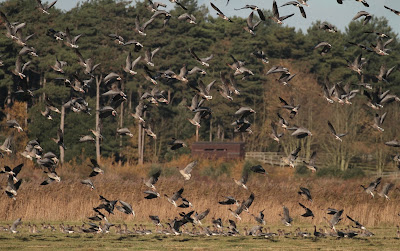One
of our traditional tasks at this time of year is the management of several of
our grassland areas. This involves cutting, either with strimmers or in some of
the larger areas with tractor and then raking up all cut material by hand. Cutting
prevents areas turning to scrub and by removing the cuttings it prevents
unwanted nutrients building up and enriching the soil. The resulting shorter
swards of grass are then good for an assortment of wild flowers which otherwise
would find it impossible to compete or survive within too much shade or with other
more vigorously growing species.
The prehensile tail of the Harvest Mouse acts like a fifth limb
By
working in such environments by hand it gives an opportunity to see close up
some of the inhabitants that are normally hidden away from view. Admittedly in
the autumn when we are doing such work there is less to be seen as most
invertebrates are coming to the end of their short lives and most plants have long
since finished flowering but there are always plenty of clues as to what has been
and what is to come! One such example of a species we seldom see is the Harvest
Mouse. Whilst these rather cute tiny golden orange rodents with their long
prehensile tails are still reasonably common in the UK south of Yorkshire and
east of Wales, they can be difficult to find, let alone observe. Declines have
been suggested due to intensive mechanised arable farming yet the true
population size is really unknown. Harvest Mice prefer rank grassland and here
on the coast, dry reedbeds. They can also be found along old hedgerows, in
fallow fields and less intensively managed farmland.
Weighing as little as four grams, the Harvest Mouse is Europe's smallest rodent
As they are Europe’s smallest
rodent they can be virtually impossible to find. Often the only clue as to
their whereabouts is the sight of a distinctive nest. This is a golf ball sized
bundle of tightly woven grass and every time we work in such places we always
find one or two Harvest Mice nests, suggesting they are actually quite
widespread across the reserve. One constant surprise is that every time we have
a tidal surge we find dead Harvest Mice. This really does suggest that there is
a far larger population out in the rank saltmarsh grasses than is generally
recognised and that they can adapt and live in conditions out of their more
normal accepted habitat.
Harvest
Mice nests have a dual purpose. Summer maternal nests are said to be solely for
that reason; producing offspring and are then abandoned. Winter roosts are said
to be in different purpose made nests, with the remnants of food, such as
discarded seed husks being a sign of recent occupancy. So to see an actual
Harvest Mouse requires an awful amount of luck. Some people live a life time
and never get a glimpse of a wild, live one. Everyone recognises one from a book
as they are so distinctive and being so brightly coloured surely they should be
easy to see? No, not the case as they live close to the ground keeping well out
of the way of all manner of predators. They do venture up reeds and grass stems
quite freely due to their long hairless and prehensile tail. It really does act
like a fifth limb.
A sight that very few people have seen in the wild; a nest of young Harvest Mice
My own sightings seemed a long time coming but in recent
years working on the reserve I have been fortunate in seeing them from time to
time. Even then to see a wild one cling onto a grass stem is an incredibly
lucky experience. I have seen it only once and that came as a matter of sheer
good luck. I was walking through the dunes close to the foreshore and heard a
series of short rasping squeaks. I always try and check out such noises as you
can never be sure what you will see and on this occasion I hit gold. Literally!
Three dark golden mice scattered on the marram tops in front of me. They were
youngsters, probably only just weaned from their nest, their skinny tails
enabling them to cling precariously to the grass stems. I never saw the adults,
they were probably well hidden, but these fearless youngsters gave me my first
and only real close up experience of wild Harvest Mice doing what everyone
wants to see a Harvest Mouse do. Other than that my only other glimpses have
been whilst working. Occasionally I have flushed a golden shape as it scampers
out from some reed litter whilst reed cutting never to be seen again. More
regular observations have come when topping the marshes by tractor. Kestrels are
never far from the scene and sometimes amidst the more typical Field Vole prey
items they dive down and snatch up the odd Harvest Mouse too. Sightings such as
this combined with nests we find are certainly enough for us to know we have a
widespread population on the reserve although at what sort of densities we do
not.
Andy
Bloomfield
Warden
Many thanks to Roger Tidman for the pictures of the Harvest Mice













































